八年级英语下册unit2单元教案 - 副本
- 格式:doc
- 大小:54.00 KB
- 文档页数:9
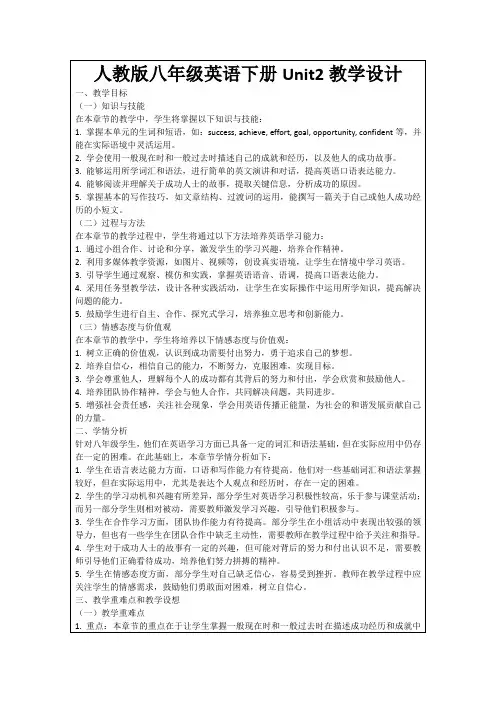
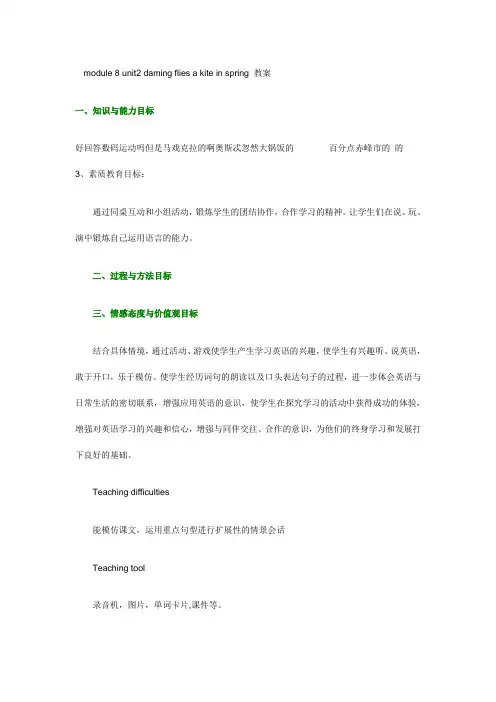
module 8 unit2 daming flies a kite in spring 教案一、知识与能力目标好回答数码运动吗但是马戏克拉的啊奥斯忒忽然大锅饭的百分点赤峰市的的3、素质教育目标:通过同桌互动和小组活动,锻炼学生的团结协作,合作学习的精神。
让学生们在说、玩、演中锻炼自己运用语言的能力。
二、过程与方法目标三、情感态度与价值观目标结合具体情境,通过活动、游戏使学生产生学习英语的兴趣,使学生有兴趣听、说英语,敢于开口,乐于模仿。
使学生经历词句的朗读以及口头表达句子的过程,进一步体会英语与日常生活的密切联系,增强应用英语的意识,使学生在探究学习的活动中获得成功的体验,增强对英语学习的兴趣和信心,增强与同伴交往、合作的意识,为他们的终身学习和发展打下良好的基础。
Teaching difficulties能模仿课文,运用重点句型进行扩展性的情景会话Teaching tool录音机,图片,单词卡片,课件等。
一、情景导入说唱chant:《In 、on 、under》in 在”里”好回答数码运动吗但是马戏克拉的啊奥斯忒忽然大锅饭的百分点赤峰市的的On 在”上”Under 在”下面”In, in , in the boxOn, on, on the desk二、集中识词1、听录音,出示单词卡,学习单词2、开火车读单词三、新知呈现1.展示多媒体课件图片, 提问“Where’s the……?”利用句型:2.说唱chant《Seasons》复习季节.《Seasons》春天,春天spring,Spring,spring百花开;夏天,夏天summer,summer,summer好炎热;秋天,秋天autumn,autumn,autumn好凉爽;冬天,冬天winter, 好回答数码运动吗但是马戏克拉的啊奥斯忒忽然大锅饭的百分点赤峰市的的3.课件或图片出示课本第一部分4个动作图片,引出:fly kites, swim , go fishing, walk.学生熟读,然后动作演示进行巩固复习。
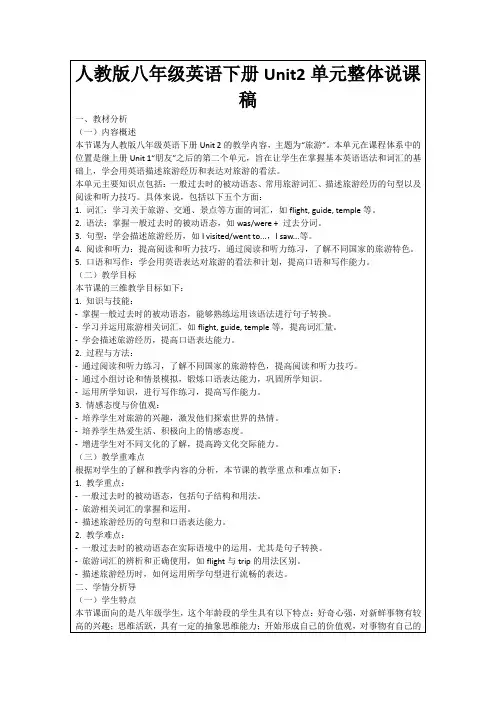
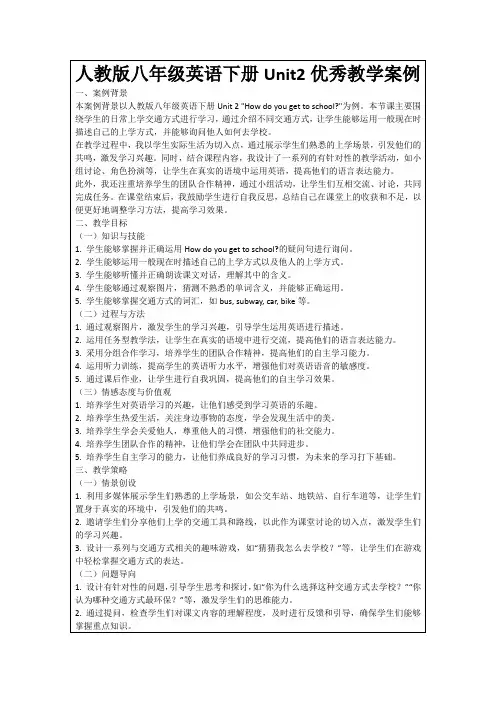
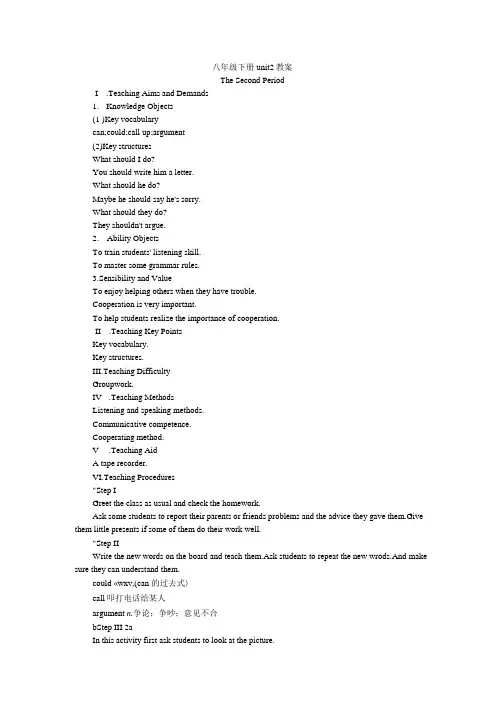
八年级下册unit2教案The Second PeriodI.Teaching Aims and Demands1.Knowledge Objects(1 )Key vocabularycan;could;call up;argument(2)Key structuresWhat should I do?You should write him a letter.What should he do?Maybe he should say he's sorry.What should they do?They shouldn't argue.2.Ability ObjectsTo train students' listening skill.To master some grammar rules.3.Sensibility and ValueTo enjoy helping others when they have trouble.Cooperation is very important.To help students realize the importance of cooperation.II.Teaching Key PointsKey vocabulary.Key structures.III.Teaching DifficultyGroupwork.IV.Teaching MethodsListening and speaking methods.Communicative competence.Cooperating method.V.Teaching AidA tape recorder.VI.Teaching Procedures"Step IGreet the class as usual and check the homework.Ask some students to report their parents or friends problems and the advice they gave them.Give them little presents if some of them do their work well."Step IIWrite the new words on the board and teach them.Ask students to repeat the new wrods.And make sure they can understand them.could «wxv,(can 的过去式)call叩打电话给某人argument n.争论;争吵;意见不合bStep III 2aIn this activity first ask students to look at the picture.Tell students they are talking about the problem.Say,Now you'll hear a conversation between Nari and a friend.Circle the word could or should you hear.Ask students to look at the chart in activity la.Show students the first column and ask a student to read it to the class.S: l.My parents want me to stay at home every night.2.My brother plays his stereo too loud.3.1don't have enough money.4.1argued with my best friend.5.My clothes are out of style.T:Very Good.Sit down,please.Now listen to the conversation.Write Nari's problem on the blank lines.Then play the recording the first time.This time students only listen.And play it a second time.As they listen to the recording this time,ask students to write Nari's problem on the blank lines in activity 2a.Then check the answers.AnswersI argued with my best friend.(This activity provides students listening practice using the target language.)TapescriptBoy l:Hey,Nari,what's wrong?Boy 2:1 had an argument with my best friend.What should I do?Boy 1: Well,you could write him a letter.Boy 2:1 don't think so.I don't like writing letters.Boy 1:Maybe you should call him up.Boy 2:No,I don't want to talk about it on the phone.Boy 1:Well,you should say you're sorry.Boy 2:Yes,I know I should,but it's not easy.Boy 1:Maybe you could go to his house.Boy 2:1 guess I could,but I don't want to surprise him.Boy 1:Hey,I know.You could give him a ticket to a ball game.Boy 2:Well,that's a good idea,but I don't have enough money.bStep IV 2bThis activity provides listening practice using the target language.First read the instructions.Show students the example match.l.You could write him a letter.I don't like writing letters.Ask students to listen again and draw lines to match the advice and the reasons.Like the sample match.Then play the recording again.Check the answers.Answersl.d 2.e 3.a 4.c 5.bbStep V 2c GroupworkThis activity provides guided oral practice using the target language.This activity demands students to role play the conversation between Nari and his friend.First tell students how to do this activity.Point to the example in the sample dialogue.Ask two students to read the conversation to the class.Point out the sentences in activity 2b.Ask two students to role play a conversation between Nari and his friend using these two sets of sentences.For example,Sa:What's the matter,Nari?S&I argued with my best friend.S a:Maybe you could call him up.Sb:I don't want to talk about it on the phone.Help the students when necessary.Then have student work in pairs.First one student is Nari and the other student is Nari's friend.Then the two students change places.At the end check the answers by calling on different pairs to say a conversation to the class.Praise them for their good job.""Step VI Grammar FocusReview the grammar box.Ask students to say the questions and the responses.Point out that the word should is always used to ask for advice,but the words could,should,and shouldn't are used to give advice.Explain that the word could is a less serious word than s/io诚d.Say,When you say someone could do something,it means that your advice is just one idea of many different ideas.When you say someone should do something,it means that your advice is the best idea or the only e the word could when you are not very sure of your e should when you are very sure of your advice.bStep VH Pronunciation NoteThe " t" at the end of the word shouldn't is usually not pronounced.And the end of the word shouldn't is often combined with the beginning of the following word.For example,s。
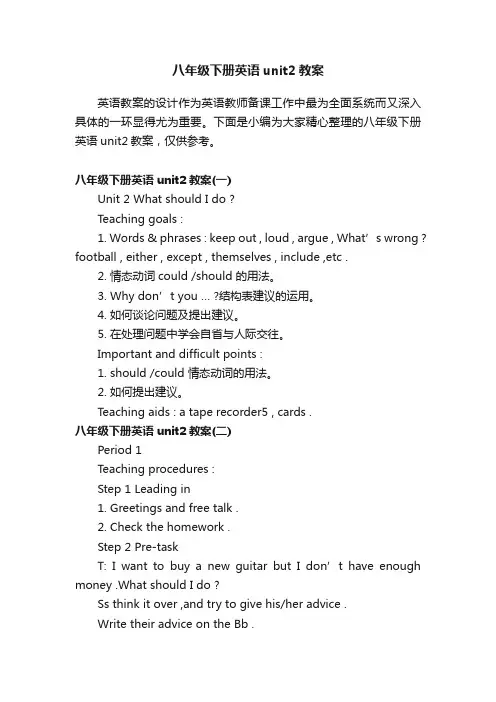
八年级下册英语unit2教案英语教案的设计作为英语教师备课工作中最为全面系统而又深入具体的一环显得尤为重要。
下面是小编为大家精心整理的八年级下册英语unit2教案,仅供参考。
八年级下册英语unit2教案(一)Unit 2 What should I do ?Teaching goals :1. Words & phrases : keep out , loud , argue , What’s wrong ? football , either , except , themselves , include ,etc .2. 情态动词could /should 的用法。
3. Why don’t you … ?结构表建议的运用。
4. 如何谈论问题及提出建议。
5. 在处理问题中学会自省与人际交往。
Important and difficult points :1. should /could 情态动词的用法。
2. 如何提出建议。
Teaching aids : a tape recorder5 , cards .八年级下册英语unit2教案(二)Period 1Teaching procedures :Step 1 Leading in1. Greetings and free talk .2. Check the homework .Step 2 Pre-taskT: I want to buy a new guitar but I don’t have enough money .What should I do ?Ss think it over ,and try to give his/her advice .Write their advice on the Bb .1. Borrow one .2. Buy a second-hand guitar .3. Get a part-time job .4. Don’t buy a guitar .5. Wait until next year .Practice reading the advice by the Ss .导入: In this unit we are going to talk about problems people have and learn how to give these people advice –to tell people what we think they should do .Step 3 While-taskSB Page 10 , 1a .1. Read the instructions to the Ss .2. Read the problems by the Ss .3. Ask Ss to write the problems in the “Serious” or “Not serious” columns .4. Explain .5. Talk about the answers with the class .Practice reading .SB Page 10 , 1b .Make sure the Ss understand what should they do .Play the tape twice .Ss circle the problems they hear .Play the tape a third time .Check the answers .Step 4 Post-taskSB Page 10 , 1c .Look at the problems in activity 1a and make conversations .Step 5 While-taskSB Page 11 , 2a .1. Read the instructions .Make sure the Ss understand what should they do .2. Point to the sentences below .3. Play the tape the first time .Ss only listen .Pay attention toPeter’s friend’s advice .4. Play the tape again .Ss circle “could” or “should” .5. Correct the answers .SB Page 11 , 2b .Read the instructions .Pay attention to Peter’s answers .Play the tape again .Check the answers .Step 7 Post-taskMake conversations with peter and his friend with the help of 2a & 2b .Step 8 Grammar FocusReview the grammar box .Ss say the questions and the responses .Explain the differences between could/should .Homework:1. Go over the words .2. My clothes are out of style ,what should I do ? Please give the advice .教学后记:八年级下册英语unit2教案(三)Period 2Teaching procedures :Step 1 Leading in1. Greeting and free talk .2. Check the homework .Collect the students’ advice .Write it down on the Bb .Step 2 Pre-task1. Review the differences between “could /should” .2. Learn the new words in Page 12 .Step 3 While-taskSB Page 12 , 3a .1. Read the instructions .2. Read the conversations by Ss or listen to the tape .Then write “good idea” “okay idea” or “bad idea” .3. Talk about the students’ answers .4. Make sure the students understand the dialogue.Practice readingStep 4 Post-taskSB Page 12 , 3b .1. Read the instructions .Point out the example conversation and ask two students to read it to the class .2. Use your head .Find some other ways to get money that aren’t in the book .3. Ask Ss to work with partner as they ask for and give advice .4. Pairwork .5. Act out the conversations to the class .Step 5 While-taskSB Page 12 , Part 4 .1. Read the instructions .Make sure the Ss understand what they should do .2. To students read the dialogue .3. Practice reading .4. Ask another pair to give their advice on another topic .5. Pairwork .Homework :将下列短语或句型译为汉语1. keep out2. out of style3. What’s wrong ?4. call sb up5. pay for6. ask for something7. summer camp 8. stay at home教学后记:。
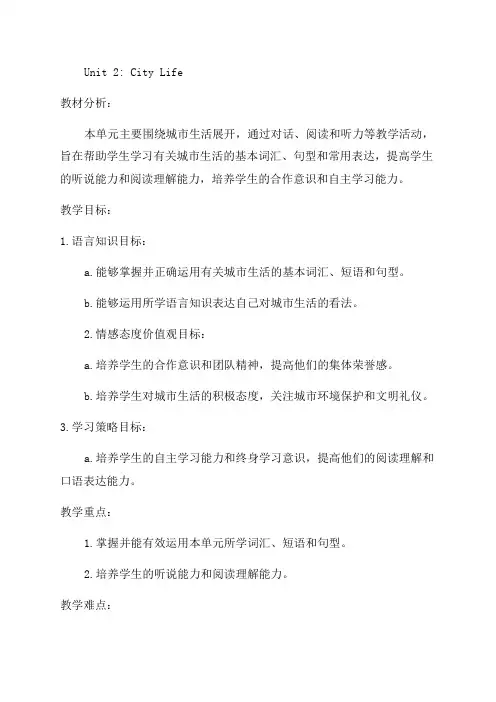
Unit 2: City Life教材分析:本单元主要围绕城市生活展开,通过对话、阅读和听力等教学活动,旨在帮助学生学习有关城市生活的基本词汇、句型和常用表达,提高学生的听说能力和阅读理解能力,培养学生的合作意识和自主学习能力。
教学目标:1.语言知识目标:a.能够掌握并正确运用有关城市生活的基本词汇、短语和句型。
b.能够运用所学语言知识表达自己对城市生活的看法。
2.情感态度价值观目标:a.培养学生的合作意识和团队精神,提高他们的集体荣誉感。
b.培养学生对城市生活的积极态度,关注城市环境保护和文明礼仪。
3.学习策略目标:a.培养学生的自主学习能力和终身学习意识,提高他们的阅读理解和口语表达能力。
教学重点:1.掌握并能有效运用本单元所学词汇、短语和句型。
2.培养学生的听说能力和阅读理解能力。
教学难点:1.运用所学语言知识表达自己的观点和看法。
2.培养学生的阅读理解能力。
教学准备:多媒体课件、录音机、课件、相应的教学素材。
教学过程:Step 1: Warm-up1. Greetings and daily report.2. Show students some pictures of different cities and ask them to discuss in pairs what they know about these cities.3. Ask some students to share their opinions.Step 2: Presentation1. Present new words and phrases by using pictures and real objects.2. Have students listen and repeat after the teacher, paying attention to the pronunciation and intonation.Step 3: Listening1. Play the recording for listening practice.3. Check the answers as a class.4. Play the recording again and ask students to follow.Step 4: Speaking1. Show the students some pictures of different cities and ask them to talk about their favorite city using the new words and phrases.2. Have students work in pairs to discuss and share their ideas.3. Ask some pairs to share their opinions.Step 5: Reading2. Check the answers as a class.3. Have students read the passage again and underline the words they don't understand.4. Explain the meaning of the words and have students read the passage aloud.Step 6: Writing1. Ask students to write a short passage about their favorite city, using the new words and phrases.2. Have students work in pairs to check and edit their writings.3. Ask some pairs to share their writings.Step 7: Role-play1. Divide the class into groups of four and give them different roles, such as a tour guide, a tourist, a local resident, and a police officer.2. Have students work in groups to create a role-play abouta city, using the new words and phrases.3. Ask some groups to perform their role-play in front of the class.Step 8: Homework1. Review the new words and phrases learned in this unit.2. Write a short paragraph about your dream city.3. Preview the next unit.黑体部分为教学内容,可根据实际情况灵活调整。
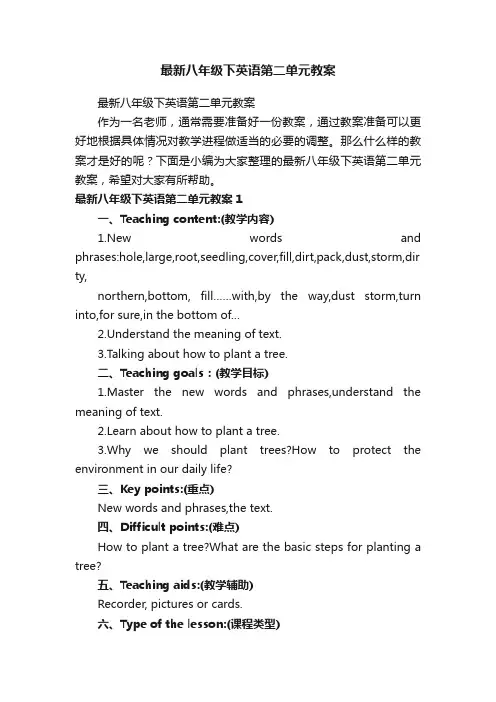
最新八年级下英语第二单元教案最新八年级下英语第二单元教案作为一名老师,通常需要准备好一份教案,通过教案准备可以更好地根据具体情况对教学进程做适当的必要的调整。
那么什么样的教案才是好的呢?下面是小编为大家整理的最新八年级下英语第二单元教案,希望对大家有所帮助。
最新八年级下英语第二单元教案1一、Teaching content:(教学内容)1.New words and phrases:hole,large,root,seedling,cover,fill,dirt,pack,dust,storm,dir ty,northern,bottom, fill……with,by the way,dust storm,turn into,for sure,in the bottom of…2.Understand the meaning of text.3.Talking about how to plant a tree.二、Teaching goals:(教学目标)1.Master the new words and phrases,understand the meaning of text.2.Learn about how to plant a tree.3.Why we should plant trees?How to protect the environment in our daily life?三、Key points:(重点)New words and phrases,the text.四、Difficult points:(难点)How to plant a tree?What are the basic steps for planting a tree?五、Teaching aids:(教学辅助)Recorder, pictures or cards.六、Type of the lesson:(课程类型)New lesson.七、Teaching procedure:(教学过程)Step 1.Analysis of the student.(学生分析)1.Greet the students in English and make sure they can response correctly.Do the duty report: a student on duty can say whatever he/she likes to say.2.Review:In last unit,we talked about the weather and spring,and we talked about some activities in spring,and we knew that,when we think of spring,we think of a season of fresh air,we think of new life,green plants all around us.3.Review the grammar:Word building.Step 2. Lead in.(引入)Homework check.Come to “Think About It”When is Tree planting Day in China?What are the basic steps for planting a tree?Step 3. New lesson.(新课)No. 1 prepare lessons before class.Teach the new words and phrases.make sure the Ss can read it correctly.No. 2Text:Give them some time to read the text themselves. Then let them act out the dialogue in groups. Correct their pronunciation when necessary.At last,the teacher explain the text in Chinese,make sure the Ss can understand the meaning of text.No. 3Important sentences:It's also a great way to learn about nature.It's fun and important to plant plants.No. 4Word building:north →northern dirt →dirtyNo. 5 Finish “Let's Do It!”Step 4. Play the tape for the Ss to follow.Make the Ss listen the text,then let them read follow the tape.Step 5.Summary. (小结)Sum up the text what we learned,the new words,phrases,and sentences.Sum up the grammar.Step 6. Homework.(作业)Finish the activity book and the practice.Copy the new words and phrases twice.Step 7.Blackboard-writing:(板书)The new words,the master phrases,important sentences.The grammar and practice.八。
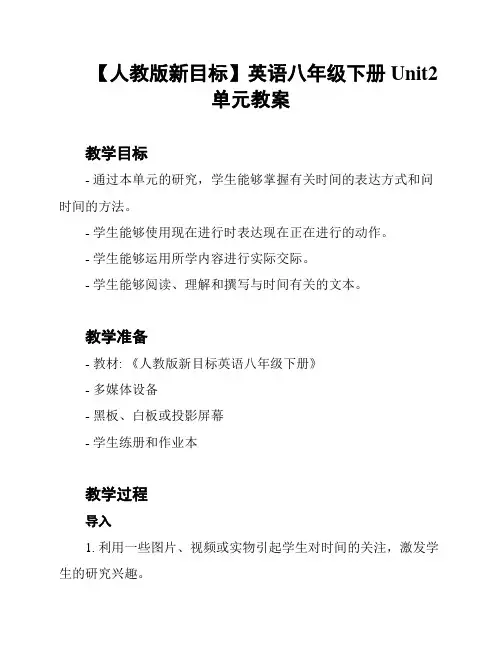
【人教版新目标】英语八年级下册Unit2
单元教案
教学目标
- 通过本单元的研究,学生能够掌握有关时间的表达方式和问时间的方法。
- 学生能够使用现在进行时表达现在正在进行的动作。
- 学生能够运用所学内容进行实际交际。
- 学生能够阅读、理解和撰写与时间有关的文本。
教学准备
- 教材: 《人教版新目标英语八年级下册》
- 多媒体设备
- 黑板、白板或投影屏幕
- 学生练册和作业本
教学过程
导入
1. 利用一些图片、视频或实物引起学生对时间的关注,激发学生的研究兴趣。
规范研究
1. 引导学生研究本单元的词汇和短语,对其进行拼读、理解和运用练。
2. 让学生听录音和跟读对话,掌握现在进行时表达现在正在进行的动作。
拓展研究
1. 带领学生进行交际练,让他们能够用英语问时间和回答时间的问题。
2. 分组进行对话练,加强学生的口语表达能力。
提升研究
1. 给学生分发阅读材料,让他们阅读并回答相关问题,加深对时间概念的理解。
2. 引导学生进行写作练,让他们写一篇短文描述自己一天的日常活动。
教学评估
- 通过学生的课堂表现和活动练,以及书面作业的完成情况来评估学生的掌握程度和进步情况。
教学延伸
- 建议学生在课后进行相关的阅读和听力练,加强对时间的理解和运用能力。
参考资源
- 《人教版新目标英语八年级下册教材》
- 互联网资源(如图片、视频、文章等)。
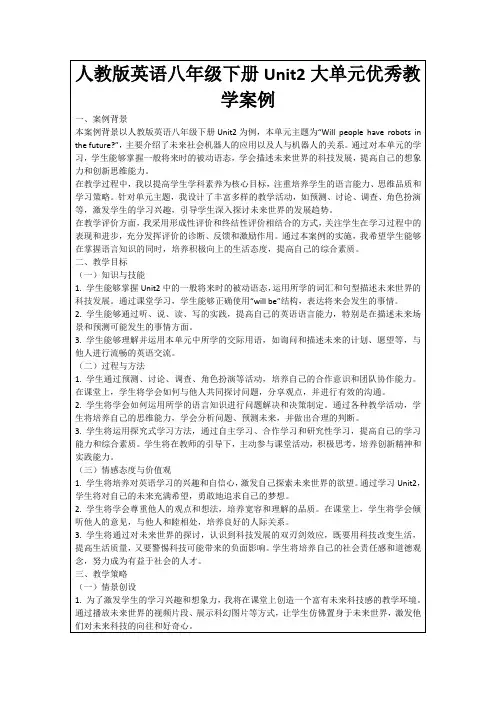

八年级英语下册Unit2教案(精选4篇)八年级英语下册Unit2 篇1unit 8 topic 11. 1)so …that …如此…以至于….,that 引导的是结果状语从句,其结构是so +形容词或副词+that 从句。
2)so…that …可以换成such +(a/an)+形容词+名词。
2. would like 作为一个固定结构后接名词,代词,不定式作宾语,也可以用不定式作宾补,表示想要的意思。
1)would like sth. 想要某物;i would like some rice and pork 。
我想要一些米饭和猪肉。
2)would like to do sth. 想要做某事。
3)would like sb. to do sth. 想要某人做某事。
would like = want 想要1. be 为助动词,made 是及物动词make 的过去分词,of 后接宾语,be made of 的主语通常为成品。
be made from 后的原材料则看不出,be made in 主语是成品,介词in 后为产地,be made into 主语为原材料,介词into 后接成品。
the table is made of wood 。
这桌子是由木头制成的。
(可以看出原材料)paper is made from wood 。
纸是由木材制成的。
(看不出原材料)the comb is made in hong kong 。
这把梳子是香港制造的。
iron is made into knives 。
铁可以制成小刀。
2. afford 常接在can ,could ,be able to 之后,意为担负的起(…的费用,损失,后果等);抽的出(时间)。
afford 还有提供,给予,出产的意思。
3. on sale 上市;折价出售,减价出售。
for sale 待售,供出售。
7. (1)though 是从属连词,引导让步状语从句,和连词but 不能连用,但翻译时需译为但是。
八年级英语下册Unit2教案牛津初中英语8BUnit2单元知识点复习I’gingnatrip“gn+表示活动的名词”表示“去参加”“去进行”某种活动Shedeidedt____________atriptthatprareaIt’ssfineadaeallfeellie____________apiniithurteaher 2Itustbefunustbe表示推测“一定是……”,否定形式为an’tbe“不可能是……”udn’tdellinurEnglishurfather________beangrandunhapp Ithinheustbeaathsteaher,__________he?3anIinu?)in+组织;taepartin+活动;attend+会议;2)insb;insbinsth/dingsth;Hisdreaist___________thePartHeisatpstudentHealas____________shlativitiesHeisagdteaherHehas______inthePartfrtentearsn’tu________usintheftballath?4anpeplelievisitingdifferentplaeslie:v喜欢;prep像uldliesth/tdsth;feellieding;llie;lieding/tdT___thetherhildren_________listeningtP3Alies,liesBlie,lielie,liesDlies,lieparentsandIarehavingafantastitieherehaveafantastitie=>enneself联想记忆haveaeal;havealessn;haveald;haveadrea;haveatr;haveal;haveaseat;haveaeeting;6Tda,espendahledainHngngDisnelandspend渡过;花费Hes_________allhisnengdbseareluenughtgtBeiing________ursuerhlida7后缀–ful与-less分别表示“有/充满……的”和“没有……的”。
英语人教版八年级下册Unit2PartA教学设计[五篇范文]第一篇:英语人教版八年级下册Unit 2 Part A 教学设计Unit 2 section A(3a-3c)教学设计教材分析:本单元的语言功能项目是“提供帮助”。
围绕“志愿活动和慈善事业”这一话题展开,Section A主要介绍单元基本语言内容,注重学生的听说能力和短语的积累。
教材通过谈论海报上帮助别人的方式导入本单元的重要句型和语法项目“动词不定式和用来表示建议的情态动词could”,然后通过听说训练落实这些语言项目。
学情分析:针对农村学生的英语基础较差,不断提高学生的学习兴趣的同时,上课还注意把握练习难度,对有问题的学生注意及时的给予帮助和鼓励。
【教学目标】Knowledge objective Get the students to be able to know the new words and expressions they learnt in this part Key words: several, feeling, satisfaction, joy, owner, journey 【教学重点】阅读短文,获得相关的信息。
通过阅读练习,来提高阅读能力。
【教学难点】理解并运用所学的词汇及表达方式【教学方法】PWP method, task-based method and interactive approach 【教学手段】A tape recorder, multimedia and some pictures 【教学过程】Teaching Procedures: Step 1 Warming up Watch a video and answer the questions.1.Where did they volunteer to work?2.What did they do there?3.What do you usually do on your free time? Would you like to volunteer to do anything for others?Ss try to answer the questions:1.They volunteered to work at the old people’s home.2.They made dumplings for the old people.They cleaned up their rooms.They talked with the old people.They sang and danced for the old people.… Step 2 Reading 1.3a:1.Tell Ss to read the article in 3a quickly and try to find the answers to these questions:(1)What does Mario love?(2)What does Mary love?(3)What do Mario and Mary volunteer to do? Ss read the article quickly and try to answer the questions: 2.方法指导:带着问题,然后快速阅读短文,争取在较短的时间内,找到答案。
八年级下学期英语第二单元教案Unit 2 I’ll help to clean up the city parks.I.Analysis of the teaching material本单元主要围绕“V olunteer and Charity”这两个相关话题展开,在offer help 的这一系列活动中学习应用一系列动词短语或句型。
Section A主要是基础语言应用,Section B在Section A的基础上进一步拓展和延伸,尤其是阅读篇目能大大提高学生阅读文章的技能和技巧。
II.Teaching Aims学生学会一些表达“向别人提供帮助”的动词短语,并学会使用“I will…”,“I would like…”等句型,向别人提供帮助。
单词advertisement, fix, repair, pleasure, blind, deaf, shut, carry, specially, fetch hunger, homeless, cheer, clean-up, sign, establish, major, commitment, elementary, veterinarian, coach, similar, call-in, strategy, disabled, organization, unable, support, appreciate, donation, part of speech, pronoun, adverb, preposition, conjunction, donate, Jimmy, Sally词组clean up, cheer up, give out, put off, set up, think up, take after, fix up, give away, put up, hand out, work out, at once熟练使用下列日常用语:1)I hope to work outside.2)I’d like to help homeless people.3)You could help to clean up the city parks.4)You could ask hospitals to let you visit the kids and cheer them up.5)She volunteer there once a week to help kids learn to read.6)She decided to try out for a volunteer after-school reading program.III.Teaching Important and Difficult points掌握“语言知识”中动词短语的用法学会使用帮助人的基本句型使用语言目标提供帮助语法:动副词短语和动介词的使用IV.Teaching PeriodsPeriod1: Section A 1a -2dPeriod2:Section A 3a -4cPeriod3: Section B 1a-1ePeriod4: Section B 2a -2ePeriod5:Section B 3a-3bV.Teaching ProceduresPeriod I: Section A 1a -2d1.Analysis of the teaching material该部分有三个模块:第一个模块围绕 ways in which you could help people这个话题展开叙述( 1a),听力(1b),口语( 1c)训练;第二个模块围绕 Talk aboutways to tell people about the Clean-Up Day 进行听力( 2a, 2b),口语( 2c)训练;第三个模块是关于志愿活动的角色表演对话。
2.Teaching Aims1)学习使用与“volunteer and charity”有关的单词和短语,能正确运用这些单词的短语表达目标语言。
2)能针对所听内容搜集和处理听力任务所要求的相关信息,并能旧话题进行对话。
3.Teaching Difficult and Important Points能准确理解不定式的功能意义,并能正确运用不定式初步描述话题情境4.Teaching ProceduresStep1.(Lead-in):展示几张需要帮助的人或事的图片。
(如:sick people,homeless children,dirty park,hunger)通过图片让学生充分展开想像力,针对每一幅图片进行描述,激起学生的同情心和对以下内容的兴趣Step2.(Presentation and practice)What can you do to help sick people?I could visit them in the hospital.I’d like to buy them some flowers.I hope to cheer them up.让学生给出不同的回答,强调I’d like to,hope to,volunteer to,could和其他动词的搭配。
老师不断强化句型,让学生有个模式进行训练.Step3. 1a, 1c, 2c.让学生根据内容对话,引出volunteer,work outside,cheer up,help sb. with sth.,give out,clean up,in the 1aospital.并用刚刚学到的目标句型来操练。
(若有学生不明白,老师可先示范一次。
)Step4 1b, 2a,2b.听力练习,学生根据录音内容完成1b,2a and 2b。
重放一遍录音内容,学生跟读。
学生通过听力练习,进一步熟悉本课的目标语言。
Step5 2d学生自由朗读对话,再分角色朗读对话安排同声翻译游戏,让学生将对话翻译出来讲解对话中的重点词汇,短语及句型Step6 Homework预习3a整理这一部分所学的短语Period II: Section A 3a-4c1.Analysis of the teaching material该部分有三个模块:第一个模块是关于volunteers的一个阅读材料,训练形式为阅读( 3a),阅读练习(3b),单词短语练习( 3c);第三个模块为Grammar Focus 是对Section A 重点句型的整理,在以练习的方式进行巩固。
2.Teaching Aims进一步熟悉与“volunteer and charity”话题相关的词汇和句型,并能根据提示写出简单的句子。
能理解动词不定式的功能意义,并能初步使用动词不定时完成适当的任务。
3.Teaching Important and difficult points动词不定式的理解和使用重点词组的使用和理解4.Teaching ProceduresStep1:Lead in 通过谈论志愿者活动,复习前期所学的目标语言,导入本节课话题Step2:Reading 通过层层深入的任务型阅读,引导学生完成对3a文本的学习,提取和处理相关信息,提高阅读技能,并初步认识和理解动词不定式。
讨论就volunteer为话题写作文的方法。
Step3:Grammar Focus 师生共同完成对单元语法知识的学习,明确其功能意义及用法。
Give out food, give out the money, put up signs, put off my plan, hand put notices, come up with some ideas, cheer up the sick children, cleanup the city parks, give up several hours, care for animals, care for them, cheer them up1)动词之后加介词或副词构成短语,表达一种特定的含义,及物动词短语须接宾语,不及物的动词短语则不需要接宾语。
2)及物动词短语所带的宾语的位置:A.名词作宾语时,对于“动词加副词”的动词短语,名词既可以放在动词短语之后,也可以放在动词短语中间。
对于“动词加介词”的动词短语,名词放于介词之后。
B.代词作宾语时,对于“动词加副词”的动词短语,代词放于动词短语之间,对于“动词加介词”的动词短语,代词放于介词之后。
Step4:Practice 完成4a,4b,4c的训练任务,在实践运用中巩固所学目标语言及语法。
Step5:Self Check 检查学生对Section A的主要语言点的掌握情况。
Step6:Homework 复习巩固Section A所学的动词短语,并加以实践运用。
Period III(Section B 1a-1e)1.Analysis of the teaching material该部分有二个模块:第一模块是词汇的学习( 1a)与运用(1b);第二个模块以听力训练形式强化第一模块中所学词汇( 1c, 1d)和口语训练( 1e)2.Teaching Aims学习使用与“volunteer and charity”话题相关的词汇短语,如:run out of, take after, fix up, give away等等。
能针对所听内容记录所需信息,并能就所听内容进行对话。
3.Teaching Important and Difficult Points掌握与话题相关的重点词汇,学会使用课本目标语言谈论话题在听的过程中准确获取信息。
4.Teaching ProceduresStep1:lead in 师生一起复习Section A中的动词短语,进一步明确动词短语的用法。
Check the homework. Review the phrasal verbs learned in SectionA and talk about the usage of the phrasal verbs.Step2:Presentation 利用图片引导学生学习新的动词短语,准确理解其意义及用法,并丰富话题词汇。
Ask the students to look to look at the pictures and learn the following phrasal verbs: run out of, take after, fix up, give away.Step3:Practice 通过1a,1b的训练,进一步理解,巩固和运用新学的动词短语,充实语言知识,提高语言技能。